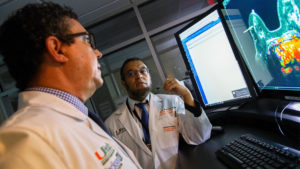Radiology has long been one of the stalwart pillars in the field of medical care domain. Radiologists have always helped physicians and patients with fast diagnosis enabling prompt treatment responses. So far, images have played a critical role in the entire process.
With the advancement in technology, radiology is looking forward to adopting AI-integrated methods for better and faster interpretations. However, all radiologists do not feel alike about the adoption of new methodologies.
Therefore a team of expert researchers conducted a study to understand the underlying trend and sensitivity of the rads about this entire idea of AI tool adoption.
AI has already become one of the most reliable technological tools for all domains of work. In the medical care sector, AI can offer accuracy, time-saving methods, and effortless diagnosis.
With so many advantages linked to AI-integrated methodologies, radiologists are hopeful about incorporating it into the mainstream tasks of radiology. Almost 60% of radiologists have so far expressed a clear intention of integrating artificial intelligence into their daily mode of clinical practices in the times to come.

The Study
A team of researchers conducted a questionnaire-based study during the process of mammography screening. The data thus drawn revealed a sharp inclination towards the use of AI techniques for cancer detection support and risk prediction requirements. The American College of Radiology journal recently published this novel trend in radiologists.
Kathryn P. Lowry works at Washington University’s radiology department associated with Seattle Cancer Care Alliance. Lowry and his colleagues published this elaborate study and their remarks and conclusions on it in the journal.
The Outcome
The team of researchers remarked that AI is becoming increasingly relevant for radiology works with every passing day. While more people are adopting AI for accurate diagnosis, risk predictions, and more, the impact of such integrations on radiologists still remains indefinable.
The team further remarked that the integration of AI would directly impact radiologists. Therefore, the influence of AI-integrated techniques on the radiology sector and its practitioners remains a critical aspect to think of.
The authors further mentioned that the FDA, Food and Drug Association of the US, has recently approved several AT-enabled mammography interpretation tools for clinical use. All of these will remain available in the market for commercial purposes. The team also mentioned that the pace of production of the latest AI-powered support tools for mammography decisions has already gained momentum. However, which of these tools will be adept for regular radiology practices still remain a matter of quandary.
To develop an in-depth understanding of the matter, the researchers interviewed the radiologists in a quantitative pattern. Their motto was to comprehend the radiologists’ intentions regarding the use of AI support tools.
The Result
The study illuminated the researchers by helping them to identify five critical factors related to the detection of breast cancer and four more attributes for risk prediction for breast cancer patients. Based on this data the team of researchers invited around 150 U.S. A-based radiologists to take part in a DCE (discreet choice experiment) developed by the team.
Out of these 150 radiologists, 66 responded to their appeal. This group of 66 radiologists included experts from six different practice settings in eight states.
The participants clearly mentioned that they expect to deal with tools capable of achieving sensitivity for 94% and specificity for less than 25% of the cases.
They further clarified that they would prefer working with AI tools with Ai mark-ups appearing at the end of the hanging protocols once the interpretations are over. However, for risk predictions, the radiologists voted for models integrating clinical data and mammography images.
When asked about their intention to include AI-enabled tools for risk prediction and cancer detection in regular radiology practices, 46-60% of rads showed a positive inclination towards the adoption of AI-integrated methods in the future.
On the other hand, 26-33% of the rads appreciated the enormous potential, AI integrated methods have, but hesitated to adopt the technique forthrightly. However, the group of 66 participants had a few radiologists who disregarded every possibility of adopting AI methods and tools, no matter the advantages entwined or the features integrated.
Lowry and colleagues suggested that their findings based on the study may help in the process of mobilizing resources in accordance with the priority to develop AI tools with advanced features for AI tools regulation, real-world implementation, and mammography screening.
The team further added that in the future, similar endeavors should concentrate on other stakeholders like payers’ and patients’ preferences.
At sepStream®, we understand the value of timely and flawless detection of deadly diseases like cancer. Therefore, we integrate nothing short of the best AI-integrated technique into our software to aid in the process of radiology and beyond. With our upgraded and advanced tools and software, you can deliver improved medical care to all your beneficiaries.